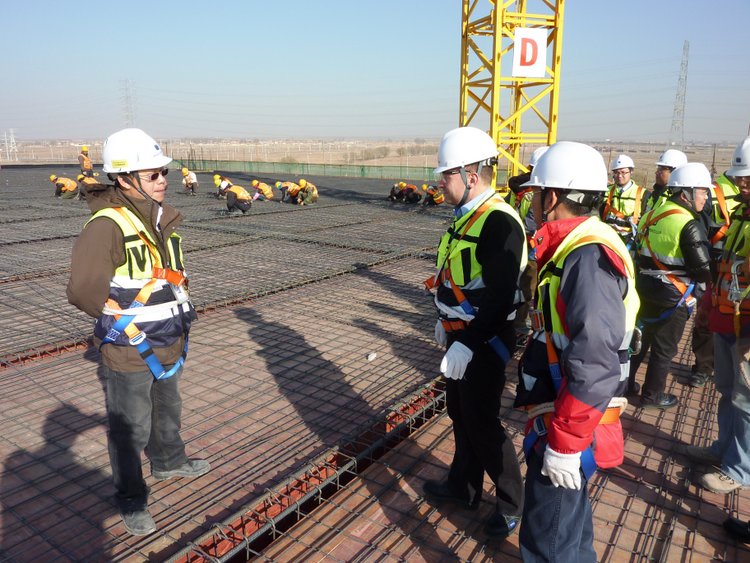How Important Is Compliance to the Construction Industry and Does It Matter to My Construction Project?
Construction Compliance Is a Minor Hassle That Prevents Major Setbacks.
An Introduction to Compliance
Compliance can mean many things to many people. Teachers train compliance from their students, while governments demand it from their citizens. Companies have entire departments dedicated to handling it.
Merriam-Webster defines compliance as “conformity in fulfilling official requirements”. Construction firms are not above being subject to official requirements. While physical requirements like safety regulations and building code are front and center with enforcement, proof of various records must be produced as well.
So where do these requirements come from, what are they, what do they accomplish, and how does skirting them play out in the real world? Today we’ll be examining the various facets of construction compliance- particularly documentation and records- and how it can affect the company at the project level.
Merriam-Webster defines compliance as “conformity in fulfilling official requirements”. Construction firms are not above being subject to official requirements. While physical requirements like safety regulations and building code are front and center with enforcement, proof of various records must be produced as well.
So where do these requirements come from, what are they, what do they accomplish, and how does skirting them play out in the real world? Today we’ll be examining the various facets of construction compliance- particularly documentation and records- and how it can affect the company at the project level.
Punishments: Fines and Lawsuits
Many government and regulatory bodies enforce compliance standards with issues such as safety, training, licensure, and liability. OSHA 10/30 certifications, First Aid requirements, and more specialized safety certs (like PPE, Rigging, Fall hazard, etc.) that demonstrate training and capability should be familiar by now. Various contractor’s licenses, heavy equipment licenses, and other licenses that legally sanction work are mandated by states and their agencies. Local municipalities can have their own standards for wage and payroll, proof of local hires, and more. Recent events have brought requirements in some states and municipalities to demonstrate proof of Covid-19 vaccination.
Failure to comply with government certification requirements can bring down a heap of trouble on a project site. Workers that don’t possess the required training, safety, and license credentials (or possess lapsed certifications) can earn heavy fines for the company. OSHA, for instance, will penalize contractors $13,494 for every safety violation they find on site; if several workers have expired certifications, the fines begin to add up. Not correcting the violations by the required deadline brings about daily accruing penalties, and “willful” violations multiply the previous amount by 10x. State and local bodies can levy their own penalties, and even worse, can forcefully shut down site activity and remove licenses as their discretion.
Liability is another avenue whereby lack of compliance can become a chink in the company’s armor. Imagine: a worker falls from scaffolding and becomes injured; an investigation determines that the worker did not possess scaffolding training, yet was approved to work by the project manager. This opens the company up an avenue of attack for a lawsuit or workers comp claim. Regardless of who actually causes an accident, courts occasionally find GCs responsible- and letting workers on site without up-to-date safety credentials can tip the balance in favor of the plaintiff.
Contractual agreements between clients, general contractors and subcontractors can always become vectors for conflict. Should a GC and a client disagree over the quality of a project, the contract becomes its own form of compliance. If a client believes the work to be shoddy, subpar, and in violation of contractual agreement, they may embroil the contractor in a civil suit. Should it come to light that workers on the site were operating without licenses to validate their competence, the plaintiff would have a greater probability of a favorable ruling, potentially extracting more time or money from the contractor.
Failure to comply with government certification requirements can bring down a heap of trouble on a project site. Workers that don’t possess the required training, safety, and license credentials (or possess lapsed certifications) can earn heavy fines for the company. OSHA, for instance, will penalize contractors $13,494 for every safety violation they find on site; if several workers have expired certifications, the fines begin to add up. Not correcting the violations by the required deadline brings about daily accruing penalties, and “willful” violations multiply the previous amount by 10x. State and local bodies can levy their own penalties, and even worse, can forcefully shut down site activity and remove licenses as their discretion.
Liability is another avenue whereby lack of compliance can become a chink in the company’s armor. Imagine: a worker falls from scaffolding and becomes injured; an investigation determines that the worker did not possess scaffolding training, yet was approved to work by the project manager. This opens the company up an avenue of attack for a lawsuit or workers comp claim. Regardless of who actually causes an accident, courts occasionally find GCs responsible- and letting workers on site without up-to-date safety credentials can tip the balance in favor of the plaintiff.
Contractual agreements between clients, general contractors and subcontractors can always become vectors for conflict. Should a GC and a client disagree over the quality of a project, the contract becomes its own form of compliance. If a client believes the work to be shoddy, subpar, and in violation of contractual agreement, they may embroil the contractor in a civil suit. Should it come to light that workers on the site were operating without licenses to validate their competence, the plaintiff would have a greater probability of a favorable ruling, potentially extracting more time or money from the contractor.




Consequences: Costs and Friction
Beyond the types of penalties that can be imposed from without, ignoring safety and skill compliance can strain the company from within. While safety training, skills certifications, and other requirements can seem like an externally imposed burden, they can keep your workforce conscious of, and refreshed on, best practices- which means they are less likely to make costly mistakes. That not only includes what OSHA, states, and accreditation bodies require, but also your company’s own safety policies and employee agreements.
Safety incidents, or other accidents, are going to cost the project site in lost productivity. Workforce morale may dip after an incident, and cause many workers to wastefully avoid what they see as “risk” areas. Precious man-hours will be spent after the accident cleaning up, as well as identifying the problem and drafting up directives or policies to avoid the same outcome. If equipment is damaged or broken, time and money will have to be spent on repairs or replacements. Reputation may suffer with clients as well as customers who see your accidents, causing strained business relationships or missed opportunities down the line. Insurance hikes and legal fees may be in the offing, even if a court ruling is favorable.
Skills requirements are another avenue whereby lax compliance at the site can severely damage a project schedule. Quality management is essential, and there is always a risk of hiring workers or contractors who know less than they pretend to. One of our clients, in the process of building a shipyard platform, had brought on a subcontractor for undersea welding. The subcontractor’s poor workmanship required the project to be redone, with an additional cost exceeding a million dollars.
After looking into the matter, the GC discovered that the subcontractor didn’t have the necessary certifications in underwater welding. A little bit of diligence in screening for certifications might have saved the GC a huge headache. While certifications aren’t the end-all-be-all of worker skill and ability, they can help screen out the worst of the worst.
Safety incidents, or other accidents, are going to cost the project site in lost productivity. Workforce morale may dip after an incident, and cause many workers to wastefully avoid what they see as “risk” areas. Precious man-hours will be spent after the accident cleaning up, as well as identifying the problem and drafting up directives or policies to avoid the same outcome. If equipment is damaged or broken, time and money will have to be spent on repairs or replacements. Reputation may suffer with clients as well as customers who see your accidents, causing strained business relationships or missed opportunities down the line. Insurance hikes and legal fees may be in the offing, even if a court ruling is favorable.
Skills requirements are another avenue whereby lax compliance at the site can severely damage a project schedule. Quality management is essential, and there is always a risk of hiring workers or contractors who know less than they pretend to. One of our clients, in the process of building a shipyard platform, had brought on a subcontractor for undersea welding. The subcontractor’s poor workmanship required the project to be redone, with an additional cost exceeding a million dollars.
After looking into the matter, the GC discovered that the subcontractor didn’t have the necessary certifications in underwater welding. A little bit of diligence in screening for certifications might have saved the GC a huge headache. While certifications aren’t the end-all-be-all of worker skill and ability, they can help screen out the worst of the worst.
Getting Lost in Paper Trails
You may, in fact, have screened all your workers correctly. But the method with which you manage their credentials is important as well. Relying on paper filing systems to organize compliance can result in lost documents or delays from searching for them. Physical records are easily misfiled, and companies that scale up in the hundreds of employees multiply the organizational chaos. Paper documents are vulnerable to destructive events like floods and fires.
Certifications may not be readily available when an inspector comes to the job site, leading to increased scrutiny and unnecessary paperwork down the line. Disorganization can cause routine audits to turn into unwelcome expenses. Office of Federal Contract Compliance audits, for instance, result in millions in fines for contractors every year. Some of these fines are the result of poor collection and filing systems- employment records misfiled, payroll records spread over multiple locations- and are quite avoidable.
By using a manual paper process for filing, important dates for renewals can get overlooked. Without any kind of automated process for reminding supervisors of when certificates and licenses expire, expiration dates easily come and go without anyone’s knowledge.
Project managers should be able to both easily access data and make information widely available in the company, but in our experience, many of them treat compliance tracking as an eye-rolling nuisance. On the flipside, pro-active managers can use the threat of punishment or harm to transform their record keeping, across the entire company. Virtual badge systems are a powerful tool that many of those forward-looking managers have implemented to tackle their jobsite compliance.
Certifications may not be readily available when an inspector comes to the job site, leading to increased scrutiny and unnecessary paperwork down the line. Disorganization can cause routine audits to turn into unwelcome expenses. Office of Federal Contract Compliance audits, for instance, result in millions in fines for contractors every year. Some of these fines are the result of poor collection and filing systems- employment records misfiled, payroll records spread over multiple locations- and are quite avoidable.
By using a manual paper process for filing, important dates for renewals can get overlooked. Without any kind of automated process for reminding supervisors of when certificates and licenses expire, expiration dates easily come and go without anyone’s knowledge.
Project managers should be able to both easily access data and make information widely available in the company, but in our experience, many of them treat compliance tracking as an eye-rolling nuisance. On the flipside, pro-active managers can use the threat of punishment or harm to transform their record keeping, across the entire company. Virtual badge systems are a powerful tool that many of those forward-looking managers have implemented to tackle their jobsite compliance.

The Final Answer to Compliance Woes
A virtual badge system is an integrated solution that offers compliance paperwork centralization, credential tracking, and real time document management. When implemented properly, it makes overseeing compliance on the construction site effortless.
Under such a system, every worker on the site is assigned a digital ID badge, which holds all of their necessary credentials. Many of these credentials will be required before the worker is ever hired or sets foot on the website, which makes the badges an effective dovetail between onboarding and compliance. Each worker must upload their up-to-date documentation to their badge, which is then scanned in a simple site access process. Any workers with expired certifications cannot obtain badges, and must rectify their standing before beginning work. This also applies to workers whose credentials expire during their employment- who are denied site access. Fortunately, virtual badge systems can be used to track certification expiration dates and send automated reports of impending expirations.
What types of documentation can digital ID badges store?
• OSHA safety certifications
• Advanced training certifications
• Agreements to site specific safety policies
• Contractor licenses
• Equipment licenses
• Vaccinations/medical certificates
• Wage/union payroll agreements
• Background checks
• Insurance/bonding requirements
• Subcontractor agreements
• PPE training
• First Aid training
While this list is by no means exhaustive, it is meant to give the reader some indication of the breadth of storable and trackable compliance.
With a virtual badge system fully integrated into the workforce and the site access protocols, noncompliant workers never have to threaten the company’s position again. Automated tracking and access grant/denial processes take the burden off of both project managers and HR while guaranteeing conformity with regulations.
All documentation is centralized- easily accessible from any office and from any mobile digital ID badge, ensuring both timely cooperation with detailed audits, and satisfying random site inspections. Stored in a cloud database, compliance records are never lost, misfiled, or destroyed.
Most importantly, with an air tight structure operating in place, virtual badge systems shield construction companies from risk exposure tied to noncompliance. By ensuring that workers are in conformity with regulation, the opportunity for related fines and regulatory punishments is removed. Many aspects of company liability are eliminated, adding protection against numerous types of civil suits. Ensuring the right qualifications also fosters higher worker skill, quality, care and safety. Rather than bleeding out thousands or millions of dollars in fines, suits, workers comp, catastrophic accidents, and botched jobs, project managers can staunch the losses, reduce risk, and hire the right talent.
While some supervisors may not be taking worker certifications seriously, I guarantee that their C-suite executives do when an incident or inspection occurs. In an ever increasingly regulated and litigated environment, there’s no reason to hand ammunition over to outside parties. Virtual badge systems take care of all workforce compliance record keeping, period. If staying out of trouble- and on schedule- sounds good, then why risk it? Talk to one of Virtual Badge’s experts today, and we’ll help you cover your bases for good.
Under such a system, every worker on the site is assigned a digital ID badge, which holds all of their necessary credentials. Many of these credentials will be required before the worker is ever hired or sets foot on the website, which makes the badges an effective dovetail between onboarding and compliance. Each worker must upload their up-to-date documentation to their badge, which is then scanned in a simple site access process. Any workers with expired certifications cannot obtain badges, and must rectify their standing before beginning work. This also applies to workers whose credentials expire during their employment- who are denied site access. Fortunately, virtual badge systems can be used to track certification expiration dates and send automated reports of impending expirations.
What types of documentation can digital ID badges store?
• OSHA safety certifications
• Advanced training certifications
• Agreements to site specific safety policies
• Contractor licenses
• Equipment licenses
• Vaccinations/medical certificates
• Wage/union payroll agreements
• Background checks
• Insurance/bonding requirements
• Subcontractor agreements
• PPE training
• First Aid training
While this list is by no means exhaustive, it is meant to give the reader some indication of the breadth of storable and trackable compliance.
With a virtual badge system fully integrated into the workforce and the site access protocols, noncompliant workers never have to threaten the company’s position again. Automated tracking and access grant/denial processes take the burden off of both project managers and HR while guaranteeing conformity with regulations.
All documentation is centralized- easily accessible from any office and from any mobile digital ID badge, ensuring both timely cooperation with detailed audits, and satisfying random site inspections. Stored in a cloud database, compliance records are never lost, misfiled, or destroyed.
Most importantly, with an air tight structure operating in place, virtual badge systems shield construction companies from risk exposure tied to noncompliance. By ensuring that workers are in conformity with regulation, the opportunity for related fines and regulatory punishments is removed. Many aspects of company liability are eliminated, adding protection against numerous types of civil suits. Ensuring the right qualifications also fosters higher worker skill, quality, care and safety. Rather than bleeding out thousands or millions of dollars in fines, suits, workers comp, catastrophic accidents, and botched jobs, project managers can staunch the losses, reduce risk, and hire the right talent.
While some supervisors may not be taking worker certifications seriously, I guarantee that their C-suite executives do when an incident or inspection occurs. In an ever increasingly regulated and litigated environment, there’s no reason to hand ammunition over to outside parties. Virtual badge systems take care of all workforce compliance record keeping, period. If staying out of trouble- and on schedule- sounds good, then why risk it? Talk to one of Virtual Badge’s experts today, and we’ll help you cover your bases for good.
